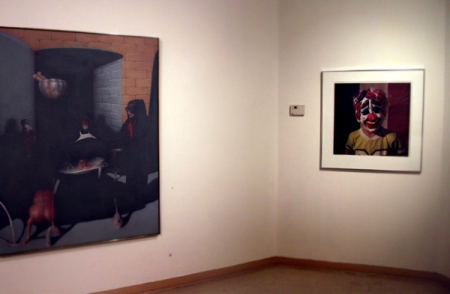Curatorial Smack Down: Round 1
January 26 to February 1, 2010
The Challenge:
Using work from the Gallery Lambton Permanent Collection “out-curate” the opponent.
The Objectives:
- To learn more about curating.
- To learn more about the collection.
The Process:
- Using works from the permanent collection; select, place, inform and defend your choice.
- In response to your opponent and within 12 hours; select, place, inform and defend your choice.
- Repeat. Repeat. Repeat. Repeat. Repeat. Repeat.
- On day 7, each contender, in addition to their final selection, has the option to switch or replace one work from the exhibition.
- Discuss, critique, share and enjoy the process and the exhibition.
The Questions:
How do collections produce meaning?
How do curators produce meaning?
How does meaning of the work and of the exhibition shift?
++++++++++++++++++++++++++++++++++++++++++++++++++++++++++++++++++++++++++++++++++
Although the gallery has been busy with tours and promotion for the new gallery lambton, Cam Starr & Lisa Daniels were able to sit down and talk candidly about their first selections.
Lisa
John Boyle, a London Ontario artist was involved in the artist run centre/london arts movement. His work is considered extremely Canadian to the point of being almost anti-American. Coming from a strong group of artistic supporters, Boyle has an interesting tie to Sarnia. During his career he wanted to have a painting in a group show at the London Museum but his painting, that of himself, naked in a chair, was considered to risqué. Since he was denied admittance to the show, all of his friends pulled their pieces out of the show in protest. The shows next stop was in Sarnia where all of the pieces were displayed.
Lisa explained that the past curator had acquired 52 works by Boyle, an artist that she herself has a difficult time with. As a curator one must seperate themselves from works that they are naturally drawn to and expand to display works that are more difficult and challenging. She found herself asking why the gallery has 52 of his pieces. She also wanted to display this piece as it has never been hung in the gallery and set up for public viewing.
Some of the other things that Lisa commented on were the harsh yellow, nearly florescent colouring combined with raw canvas makes the piece very difficult to light, especially considering the lighting available in this gallery. She wondered also if the artists intention was to light it in a particular way, if it was to create a portrait that seems like more of a memory that one has to squint at in order to make out the image.
Cam
After spending much time looking through the permanent collection, Cam decided to chose a piece that was also not something he would ordinarily be drawn to: Edward Godwin’s Western Summer: Day’s End on Moab #5, 1980. Originally focused on more modern prints and almost choosing a John Boyle himself, Cam selected this large painting due to its combination of traditional painting techniques and the odd cropping of the image. Quick to comment that the painting was cropped much in the same way as a portrait would be, Cam explained the draw of this image.
The scene represented in this painting is very fleeting; one can never step in the same river twice. Noting that this image was probably not painted from a photograph, but rather from a sketch or a memory, Cam found the image to be very personal. He commented that even if one was to find that exact same location, they would never be able to recreate the feeling in this painting, that this was a “portrait of a moment.”
Not usually inclined to gravitate towards landscape images, Cam also stepped outside of his comfort zone in his selection.
Both Cam & Lisa will be providing a more thorough and researched statement about their selection, but their candour provides an interesting look at their first selections. They will write out their statements and responses on typewriters which sit in the gallery, available to viewers who are passing through.
This “smack down” will be going now through monday the 1st. Stay tuned for the curators responses and watch the exhibit flourish.
+++++++++++++++++++++++++++++++++++++++++++++++++++++++++++++++++++++++++++++++++


































































